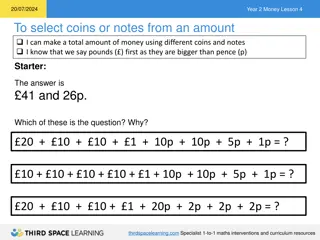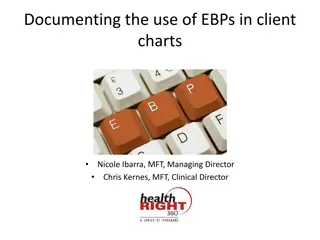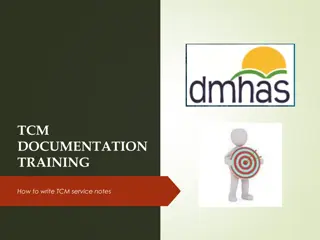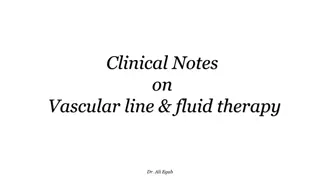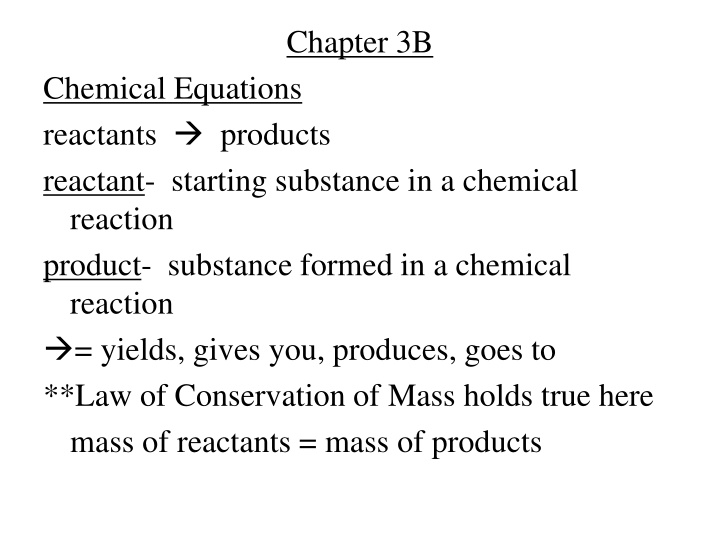
Chemical Reactions: Understanding Equations and Types
Explore the fundamentals of chemical reactions, including balancing equations, types of reactions, and examples. Learn about reactants, products, the law of conservation of mass, and the role of catalysts. Try your hand at balancing equations for various reactions.
Download Presentation

Please find below an Image/Link to download the presentation.
The content on the website is provided AS IS for your information and personal use only. It may not be sold, licensed, or shared on other websites without obtaining consent from the author. If you encounter any issues during the download, it is possible that the publisher has removed the file from their server.
You are allowed to download the files provided on this website for personal or commercial use, subject to the condition that they are used lawfully. All files are the property of their respective owners.
The content on the website is provided AS IS for your information and personal use only. It may not be sold, licensed, or shared on other websites without obtaining consent from the author.
E N D
Presentation Transcript
Chapter 3B Chemical Equations reactants products reactant- starting substance in a chemical reaction product- substance formed in a chemical reaction = yields, gives you, produces, goes to **Law of Conservation of Mass holds true here mass of reactants = mass of products
-the states of matter can be indicated after the substance (s)=solid ( )=liquid (g)=gas (aq)=aqueous = reversible reaction catalyst- substance that speeds up the rate of a reaction without being used up in the reaction **written above the arrow ex- Pt = heat applied
**Remember H O N C Br I F skeleton equation- chemical equation that is not balanced ex- Write a skeleton for the following reaction: solid iron reacts with oxygen to form solid iron (III) oxide Fe(s) + O2(g) Fe2O3(s)
Try these: 1) solid sodium hydrogen carbonate reacts with hydrochloric acid to produce aqueous sodium chloride, water and carbon dioxide 2) solid sulfur burns in oxygen to form sulfur dioxide 3) solid potassium chlorate forms oxygen and solid potassium chloride in the presence of catalyst manganese(II) oxide
Answers 1)NaHCO3(s) + HC (aq) NaC (aq) + H2O ( ) + CO2(g) 2) S(s) + O2(g) SO2(g) 3) KC O3(s) MnO O2(g) + KC (s)
Balancing Equations -each side of the equation (reactants and products) must have the same # of each element -some may already be balanced -must be lowest whole # ratio -balance by putting coefficients in front of compounds
Types of Chemical Reactions 1) Combination/Synthesis Reaction -two or more substances combine to form a single substance reactants- two elements or two compounds products- always a compound ex- 2K + C 2 2KC ex- SO2+ H2O H2SO3
Try these!! Dont forget to balance!! a) aluminum + oxygen A + O2 A 2O3 b) copper + sulfur (two possible reactions) Cu + S Cu2S or Cu + S CuS c) beryllium + oxygen Be + O2 BeO d) strontium + iodine Sr + I2 SrI2 e) magnesium + nitrogen Mg + N2 Mg3N2
2) Decomposition Reaction -one compound breaks down or decomposes into two simpler compounds -the reverse of synthesis ex- 2H2O 2H2+ O2 Try these!! a) lead(IV) oxide b) hydrogen iodide c) hydrogen bromide d) sodium chloride
a) PbO2 Pb + O2 b) 2HI H2+ I2 c) 2HBr H2+ Br2 d) 2NaC 2Na + C 2 3) Single-Replacement Reactions -one element replaces a second element in a compound ex- 2K + CaO K2O + Ca -whether one metal will replace another metal is determined by reactivity of the metal
activity series of metals- lists metals in order of decreasing reactivity
ex- Mg + Zn(NO3)2 *is Mg above Zn on the reactivity series? Mg + Zn(NO3)2 Mg(NO3)2+ Zn ex- Mg + Ag2SO4 Mg + Ag2SO4 MgSO4 + 2Ag ex- Mg + LiNO3 -lithium is above magnesium Mg + LiNO3 no reaction
-Halogens can replace each other in single- replacement reactions -Reactivity decreases as you go down the halogen group Try These!! a) zinc + hydrogen sulfate b) chlorine + sodium bromide c) zinc + sodium nitrate d) iron(II) + lead(II) nitrate e) chlorine + sodium iodide
a) Zn + H2SO4 H2+ ZnSO4 b) C 2+ 2NaBr Br2+ 2NaC c) Zn + NaNO3 no reaction d) Fe + Pb(NO3)2 Pb + Fe(NO3)2 e) C 2+ 2NaI I2+ 2NaC
4) Double-Replacement Reactions -involve an exchange of cations between two reacting compounds ex- BaC 2+ K2CO3 BaCO3+ 2KC ex- FeS + 2HC H2S + FeC 2 Try These!! a) sodium hydroxide + iron(III) nitrate 3NaOH + Fe(NO3)3 3NaNO3+ Fe(OH)3 b) barium nitrate + hydrogen phosphate 3Ba(NO3)2+ 2H3PO4 Ba3(PO4)2+ 6HNO3
c) potassium hydroxide+hydrogen phosphate 3KOH + H3PO4 K3PO4 + 3H2O d) hydrogen sulfate + aluminum hydroxide 3H2SO4 + 2A (OH)3 A 2(SO4)3+ 6H2O
5) Combustion Reaction -hydrocarbon combined with oxygen to produce carbon dioxide and water ex- C6H6+ O2 CO2+ H2O -to balance any combustion begin with 2 in front of CxHy 2C6H6+ 15O2 12CO2+ 6H2O *if all divisible by 2 then reduce
Try These!! a) C14H26+ O2 CO2+ H2O b) C8H12+ O2 CO2+ H2O Answers! a) 2C14H26+ 41O2 28CO2+ 26H2O b) C8H12+ 11O2 8CO2+ 6H2O
Summary of Reactions 1) Combination/Synthesis R + S RS 2) Decomposition Reaction RS R + S 3) Single-Replacement Reaction T + RS R + TS 4) Double-Replacement Reaction RS + TU RU + TS 5) Combustion Reaction CxHy+ O2 CO2+ H2O
Summary of Reactions 1) Combination/Synthesis R + S RS 2) Decomposition Reaction RS R + S 3) Single-Replacement Reaction T + RS R + TS 4) Double-Replacement Reaction RS + TU RU + TS 5) Combustion Reaction CxHy+ O2 CO2+ H2O
Summary of Reactions 1) Combination/Synthesis R + S RS 2) Decomposition Reaction RS R + S 3) Single-Replacement Reaction T + RS R + TS 4) Double-Replacement Reaction RS + TU RU + TS 5) Combustion Reaction CxHy+ O2 CO2+ H2O
Summary of Reactions 1) Combination/Synthesis R + S RS 2) Decomposition Reaction RS R + S 3) Single-Replacement Reaction T + RS R + TS 4) Double-Replacement Reaction RS + TU RU + TS 5) Combustion Reaction CxHy+ O2 CO2+ H2O
Summary of Reactions 1) Combination/Synthesis R + S RS 2) Decomposition Reaction RS R + S 3) Single-Replacement Reaction T + RS R + TS 4) Double-Replacement Reaction RS + TU RU + TS 5) Combustion Reaction CxHy+ O2 CO2+ H2O
Summary of Reactions 1) Combination/Synthesis R + S RS 2) Decomposition Reaction RS R + S 3) Single-Replacement Reaction T + RS R + TS 4) Double-Replacement Reaction RS + TU RU + TS 5) Combustion Reaction CxHy+ O2 CO2+ H2O










